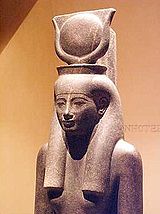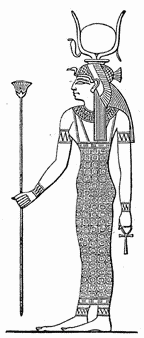Hathor

In Egyptian mythology, Hathor (Egyptian for house of Horus) was originally a personification of the Milky Way, which was seen as the milk that flowed from the udders of a heavenly cow. Hathor was an ancient goddess, and was worshipped as a cow-deity from at least 2700 BC,[1] during the second dynasty. Her worship by the Egyptians goes back earlier however, possibly, even by the Scorpion King who ruled during the Protodynastic Period before the dynasties began. His name, Serqet, may refer to the goddess Serket. The two figures flanking the top of both sides of the Narmer Palette are interpreted as images of the cow goddess. The palette is among the earliest carved religious images known from the Egyptian culture.
Hathor is referred to as She with Two Faces, which is not yet understood. Speculation about its meaning ranges from it being symbolic of life and afterlife to being the mirror and the face seen in it, but no clarification of this religious euphemism for the deity has arisen.
The name Hathor refers to the encirclement by her, in the form of the Milky Way, of the night sky and consequently of the god of the sky, Horus who was said to be her son. Later she was described as the wife of Ra, the creator whose own cosmic birth was formalised in the Ogdoad cosmogeny after his worship arose and displaced that of Horus. At that time images of Ra bear the eye motif.
An alternate name for Hathor, which persisted for 3,000 years, was Mehturt (also spelt Mehurt, Mehet-Weret, and Mehet-uret), meaning 'great flood, a direct reference to her being the milky way.[citation needed]
The Milky Way was seen as a waterway in the heavens, sailed upon by both the sun deity and the king, leading the ancient Egyptians to describe it as The Nile in the Sky. Due to this, and the name mehturt, she was identified as responsible for the yearly inundation of the Nile.
Another consequence of this name is that she was seen as a herald of imminent birth, as when the amniotic sac breaks and floods its waters, it is a medical indicator that the child is due to be born extremely soon.
Another interpretation of the Milky Way was that it was the primal snake, Wadjet, the protector of Egypt who was closely associated with Hathor and other early deities among the various aspects of the great mother goddess, including Mut and Naunet.
Hathor also was favoured as a protector in desert regions (see Serabit el-Khadim).
Associations, images, and symbols

Eventually, Hathor's identity as a cow, meant that she became identified with another ancient cow-goddess of fertility, Bat. It still remains an unanswered question amongst Egyptologists as to why Bat survived as an independent goddess for so long. Bat was, in some respects, connected to the Ba, an aspect of the soul, and so Hathor gained an association with the afterlife. It was said that, with her motherly character, Hathor greeted the souls of the dead in Duat, and proffered them with refreshments of food and drink. She also was described sometimes as mistress of the acropolis.
The assimilation of Bat, who was associated with the sistrum, a musical instrument, brought with it an association with music. In this later form, Hathor's cult became centred in Dendera in Upper Egypt and it was led by priestesses and priests who also were dancers, singers, and other entertainers.

Hathor also became associated with the menat, the turquoise musical necklace often worn by women. A hymn to Hathor says:
- Thou art the Mistress of Jubilation, the Queen of the Dance, the Mistress of Music, the Queen of the Harp Playing, the Lady of the Choral Dance, the Queen of Wreath Weaving, the Mistress of Inebriety Without End.
Essentially, Hathor had become a goddess of Joy, and so she was deeply loved by the general population, and truly revered by women, who aspired to embody her multifaceted role as wife, mother, and lover. In this capacity, she gained the titles of Lady of the House of Jubilation, and The One Who Fills the Sanctuary with Joy.
The worship of Hathor was so popular that more festivals were dedicated to her honor than any other Egyptian deity, and more children were named after this goddess than any other deity. Even Hathor's priesthood was unusual, in that both women and men became her priests.
Bloodthirsty warrior

The Middle Kingdom was founded when Upper Egypt's pharaoh, Mentuhotep II, took control over Lower Egypt, which had become independent during the First Intermediate Period, by force. This unification had been achieved by a brutal war that was to last some twenty-eight years with many casualties, but when it ceased, calm returned, and the reign of the next pharaoh, Mentuhotep III, was peaceful, and Egypt once again became prosperous. A tale, from the perspective of Lower Egypt, developed around this experience of protracted war.
In the tale following the war, Ra (representing the pharaoh of Upper Egypt) was no longer respected by the people (of Lower Egypt) and they ceased to obey his authority, which made him so angry that he sent out Sekhmet (war goddess of Upper Egypt) to destroy them. Sekhmet became bloodthirsty and the slaughter was great because she could not be stopped. As the slaughter continued, fear that all of humanity would be destroyed arose among the deities and Ra was charged with stopping her. Ra poured huge quantities of blood-coloured beer on the ground to trick Sekhmet. She drank so much of it—thinking it to be blood—that she became too drunk to continue the slaughter and humanity was saved. Afterward Sekhmet became loving and kind.
The gentle form that Sekhmet had become by the end of the tale was identical in character to Hathor, and so a new cult arose, at the start of the Middle Kingdom, which dualistically identified Sekhmet with Hathor, making them one goddess, Sekhmet-Hathor, with two sides. Consequently, Hathor, as Sekhmet-Hathor, was sometimes depicted as a lioness. Sometimes this joint name was corrupted to Sekhathor (also spelt Sechat-Hor, Sekhat-Heru), meaning (one who) remembers Horus (the uncorrupted form would mean (the) powerful house of Horus but Ra had displaced Horus, thus the change). The two goddesses were so different, indeed almost diametrically opposed, however, that the new identification did not last.
Wife of Thoth

When Horus became identified as Ra in the changing Egyptian pantheon, under the name Ra-Horakhty, Hathor's position became unclear, since in later myths she had been the wife of Ra, but in earlier myths she was the mother of Horus. Many attempts to solve this gave Ra-Horakhty a new wife, Ausaas, to solve this issue around who was Ra-Horakhty's wife and Hathor became identified only as the mother of the new sun god. However, this left open the unsolved question of how Hathor could be his mother, since this would imply that Ra-Herakhty was a child of Hathor, rather than a creator. Such inconsistencies developed as the Egyptian pantheon changed over the thousands of years becoming very complex, and some were never resolved.
In areas where the cult of Thoth became strong, Thoth was identified as the creator, leading to it being said that Thoth was the father of Ra-Horakhty, thus in this version Hathor, as the mother of Ra-Horakhty, was referred to as Thoth's wife. In this version of what is called the Ogdoad cosmogeny, Ra-Herakhty was depicted as a young child, often referred to as Neferhor. When considered the wife of Thoth, Hathor often was depicted as a woman nursing her child.
Since Seshat had earlier been considered to be Thoth's wife, Hathor began to be attributed with many of Seshat's features. Since Seshat was associated with records and with acting as witness at the judgment of souls in Duat, these aspects became attributed to Hathor, which, together with her position as goddess of all that was good, lead to her being described as the (one who) expels evil, which in Egyptian is Nechmetawaj also spelt Nehmet-awai, and Nehmetawy). Nechmetawaj can also be understood to mean (one who) recovers stolen goods, and so, in this form, she became goddess of stolen goods.
Outside the Thoth cult during these times, it was considered important to retain the position of Ra-Herakhty (i.e. Ra) as self-created (via only the primal forces of the Ogdoad). Consequently, Hathor could not be identified as Ra-Herakhty's mother. Hathor's role in the process of death, that of welcoming the newly dead with food and drink, lead, in such circumstances, to her being identified as a jolly wife for Nehebkau, the guardian of the entrance to the underworld and binder of the Ka. Nethertheless, in this form, she retained the name of Nechmetawaj, since her aspect as a returner of stolen goods was so important to society that it was retained as one of her roles.
Hathor outside the Nile river in Egypt
Hathor was worshipped in Canaan in the eleventh century BC, which at that time was ruled by Egypt, at her holy city of Hazor, or Tel Hazor which the Old Testament claims was destroyed by Joshua (Joshua 11:13, 21).
The Sinai Tablets show that the Hebrew workers in the mines of Sinai about 1500 BC worshipped Hathor, whom they identified with their goddess Astarte. Some theories state that the golden calf mentioned in the Bible was meant to refer to a statue of the goddess Hathor (Exodus 32:4-32:6.). A major temple to Hathor was constructed by Seti II at the copper mines at Timna in Edomite Seir. Serabit el-Khadim (Arabic: سرابت الخادم) (Arabic, also transliterated Serabit al-Khadim, Serabit el-Khadem) is a locality in the south-west Sinai Peninsula where turquoise was mined extensively in antiquity, mainly by the ancient Egyptians. Archaeological excavation, initially by Sir Flinders Petrie, revealed the ancient mining camps and a long-lived Temple of Hathor.
The Greeks, who became rulers of Egypt for three hundred years before the Roman domination in 31 BC, also loved Hathor and equated her with their own goddess of love and beauty, Aphrodite.
Contemporary cultural identification
This article contains weasel words: vague phrasing that often accompanies biased or unverifiable information. |
Hathor's temple at Dendera contains an image, that recently has come to be known as the Dendera Light, which some, controversially, have claimed may be a depiction of an electric lamp.

Some contemporary authors therefore associate Hathor with artificial light as evidenced by what has been purported to be a representation of electric light bulbs in this temple (see discussion at Hathor temple). Although other scholars believe the representations cited to be those of lotus flowers, spawning a snake within.
Some ancient texts refer to a great serpent of light residing in the heavens. This is believed to have been inspired by the Milky Way (a similar allusion as that of the ouroboros). The representation of this snake or ouroborus in the night sky, could be what is depicted in the relief as well. The image has not been found in any other reliefs yet discovered in excavations. The images are being held up in the sky by two deities associated with the moon and the sun while riding in the sky boat, so perhaps it represents the Milky Way great serpent in the night sky—by depicting Hauhet and the djed pillar representing Banebdjedet, Horus, or Osiris holding up the Milky Way which arches overhead from horizon to horizon.
